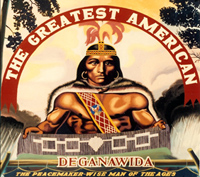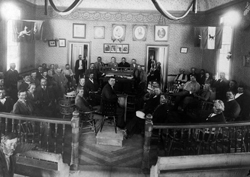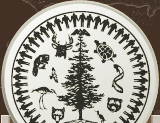Government



| Peacemaker painting by Karoniaktajeh Louis Hall.
|
Mohawk Nation at Kahnawà:ke
A Council Fire burns for the Haudenosaunee of the Mohawk Nation at Kahnawà:ke to gather about and discuss issues pertinent to the welfare of the clans. It is one of many council fires that burn within the Mohawk Nation. The Mohawk Nation at Kahnawà:ke governs itself in accordance with the Kaianere’kó:wa (the Great Law of Peace) and act as the custodians of Haudenosaunee sovereignty and interests in the Territory of Kahnawà:ke.
As Haudenosaunee citizens, who refuse to be identified as either Canadians or Americans, the Mohawk Nation at Kahnawà:ke solely recognize the Haudenosaunee Constitution as the paramount law of the land. While the Mohawk Nation at Kahnawà:ke receives no funding from the Government of Canada, it's political strength stems from its relationship with the rest of the Haudenosaunee Six Nation Iroquois Confederacy. The jurisdiction of the Mohawk Council Fire at Kahnawà:ke is limited to the Territory of Kahnawà:ke. The Longhouse; symbol of the Iroquois League
The Longhouse is the political and spiritual institution of the Iroquois Confederacy. In the times before European contact and up until the 1800’s, longhouses originally served as the living quarters of Iroquoian people. Stretching between 40 and 200 feet long, longhouses were long rectangular structures that housed a number of families belonging to a particular matrilineal clan family. Along the inner walls were open compartments for each nuclear family with a long courtyard in the center, which connected the two entrances on each end of the building. Two adjacent families would share one hearth at each compartmental increment. When the Peacemaker brought the Good Tidings of Peace and Power to the Iroquois, he used the concept of the Longhouse as the symbol of the political and spiritual union of the Iroquois Confederacy. The Kaianere’kó:wa, the Great Law of Peace, identifies specific geographically appropriate household roles for each of the Five Nations sheltered beneath the dormers of the symbolic Longhouse. The Mohawks serve as the Keepers of the Eastern Door, the Senecas as Keepers of the Western Door, and the centrally placed Onondagas serve as the Firekeepers; where all Confederate business is transacted. Each nation had its own hearth which symbolized its own domestic government, while the rafters symbolized the laws of the League; that continues to extend with every resolution of the Grand Council of Chiefs. In keeping with this central symbol, the indigenous name for the Iroquois Confederacy and its citizenry; is Haudenosaunee. The term Haudenosaunee is a variant of a western Iroquoian dialect that is generally translated as the People of the Longhouse. The Mohawk variant is Rotinonhsón:ni, which means “they are building an extended house.” Today, our Longhouse serves as a gathering place for the political, social, and spiritual functions of the traditional Mohawk Nation at Kahnawake.
Three Levels of Government
The foundation of the Haudenosaunee Confederacy is the Kaianere’kó:wa; more commonly known in English as the Great Law of Peace. This ancient doctrine provides an elaborate and efficient institution of democratic governance, social and economic stability, and a moral equation to achieve peace; both within one’s self and among the populace. It is in every sense the Constitution of the Haudenosaunee; spawning the beginning of republican democracy in North America and inspiring other nations, particularly the United States of America, to embrace this unique ideology that combines a holistically benevolent approach towards peace and inner peace with a exceptional and practical method of civic problem solving. There are three levels of government in the Haudenosaunee Confederacy; each with its own jurisdiction and authority.
Village Council Fire
Historically, each village of the Mohawk Nation had a series of political forums and councils. There were councils for each clan, men and women, as well as a general council for all members of the village. These councils served as outlets for the people to express their opinions on a variety of issues. These issues would in turn be introduced into the village’s Council of Chiefs who would deliberate over such issues and pass legislation.
A village’s Council of Chiefs was made up of leaders appointed by Clanmothers representing each of the nine extended clan families of the Mohawk Nation in that particular village; who have the power to both select and depose their Chief. Operating in the same fashion as the Mohawk Nation Council, decision making amongst the Council of the Chiefs is conducted according to clan protocols and is consensus based.
Hundreds of years ago, when longhouses were still employed as living quarters for the Iroquois, there was at least one lodge in the village that was used as their Council House; where political and social gatherings took place. Today, political gatherings and councils take place at the village Longhouse. Some Iroquois communities actually have more than one Longhouse today.
It must be noted that each community may have a slight variation in its organization. For example, it is quite common for different communities or Longhouses to have a different seating pattern for their councils.
Mohawk Nation Council Fire
The Mohawk Nation Council of Chiefs are national government of the Mohawk people. The Mohawk National Council is composed of nine chieftainship titles, representing nine extended clan families from across Mohawk Nation Territory.
Each clan family title has a Iakoiá:ner or Clanmother who selects a worthy male candidate from her matrilineal clan to serve as a Roiá:ner or Chief. A Clanmother also has the authority to remove her Chief from office.
The jurisdiction of the Mohawk National Council is limited within its territory and must adhere to the resolutions passed by the Haudenosaunee Grand Council of Chiefs. However, these nine chiefs have permanent seats on the Haudenosaunee Grand Council of Chiefs.
The following are the names of the nine clan chieftainship titles:
Ratiniáhton (Turtle Clan)
1. Tekarihó:ken
2. Aionwà:tha
3. Shate’karí:wate
Ronathahión:ni (Wolf Clan)
4. Sharenhó:wane
5. Teionhéhkhwen
6. Orenrehkó:wa
Rotiskaré:wake (Bear Clan)
7. Tehanakarí:ne
8. Rastaweseróntha
9. Shoskoharò:wane
Debates before the Mohawk National Council Fire are conducted in the following manner. The Chiefs of the Turtle Clan are responsible for hearing the matters of the people. If an issue is of particular importance to the people, the Chiefs of the Turtle Clan shall then draw the issue from the Well and introduce it to the Council. They shall then pass the issue to their brother Chiefs of the Wolf Clan.
The Chiefs of the Wolf Clan shall then discuss the standing issue. After deliberating upon the standing issue, the Chiefs of the Wolf Clan will then either support the resolution or ask their brother Chiefs of the Turtle Clan to reconsider their position with the recommendations of the Wolf Clan in mind. If both the Chiefs of the Turtle Clan and Wolf Clan become of one mind, the Chiefs of the Turtle Clan shall then pass the standing issue to their cousin Chiefs of the Bear Clan to further discuss the matter.
After deliberating upon the standing issue, the Chiefs of the Bear Clan will then either confirm the resolution or ask their cousin Chiefs of the Turtle Clan and Wolf Clan to reconsider their position with the recommendations of the Bear Clan in mind. The Council shall continue to deliberate in this fashion until they come to one mind through consensus building.
Grand Council Fire of the Haudenosaunee
The Haudenosaunee Grand Council of Chiefs, also know as the Iroquois League Council or Six Nations Confederacy Council, is the central government of the Iroquois Confederacy. The Grand Council of Chiefs is composed of fifty Chiefs representing the Five (and later Six) Nations of the Iroquois Confederacy.

| Six Nations Confederacy Council
at Grand River 1898.
|
Debates before the Grand Council Fire of the Haudenosaunee are conducted in the following manner. The Chiefs of the Onondaga Nation serve as the Council’s Firekeepers and are responsible for hearing the matters of the Haudenosaunee, who sit between the Elder Brothers and Younger Brothers. The Firekeepers shall then offer propose an issue for discussion. Each issue must be unanimously agreed upon by the Grand Council before it is drawn from the Well. Once an issue of particular importance is agreed upon for discussion, the Elder Brother Chiefs of the Seneca and Mohawk Nation shall
draw the issue from the Well and introduce it to the Council. They shall then pass the issue to Younger Brother Chiefs of the Oneida and Cayuga Nation (including the Chiefs of the Tuscarora Nation who speak through the Oneidas in Council). The Younger Brothers shall then discuss the standing issue. After deliberating upon the standing issue, the Chiefs of the Younger Brothers will then either support the resolution or ask the Elder Brother Chiefs to reconsider their position with the recommendations of the Younger Brothers in mind. If both sides of the house become of one mind, the Elder Brothers shall then pass the standing issue to the Firekeepers of the Onondaga Nation to further discuss the matter. After deliberating upon the standing issue, the Firekeepers will then either confirm the resolution or ask the Elder Brothers and Younger Brothers to reconsider their position with the recommendations of the Firekeepers in mind. The Council shall continue to deliberate in this fashion until they come to one mind through consensus building.


|



